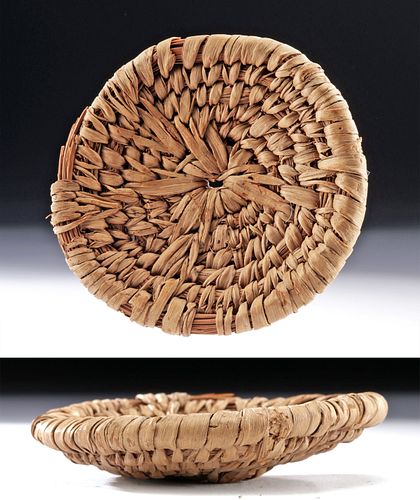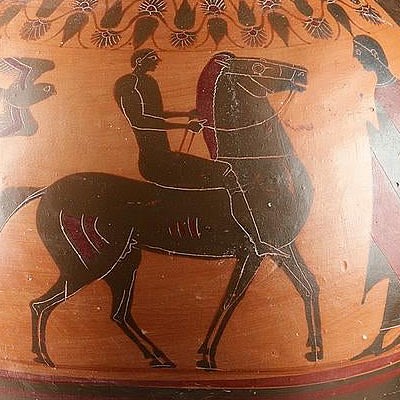Superb Egyptian Basket, ex-Sothebys, ex-Musueum
Lot 8b
About Seller
Artemis Gallery
686 S Taylor Ave, Ste 106
Louisville, CO 80027
United States
Selling antiquities, ancient and ethnographic art online since 1993, Artemis Gallery specializes in Classical Antiquities (Egyptian, Greek, Roman, Near Eastern), Asian, Pre-Columbian, African / Tribal / Oceanographic art. Our extensive inventory includes pottery, stone, metal, wood, glass and textil...Read more
Categories
Estimate:
$3,000 - $6,000
Absentee vs Live bid
Two ways to bid:
- Leave a max absentee bid and the platform will bid on your behalf up to your maximum bid during the live auction.
- Bid live during the auction and your bids will be submitted real-time to the auctioneer.
Bid Increments
| Price | Bid Increment |
|---|---|
| $0 | $25 |
| $300 | $50 |
| $1,000 | $100 |
| $2,000 | $250 |
| $5,000 | $500 |
| $10,000 | $1,000 |
| $20,000 | $2,500 |
| $50,000 | $5,000 |
| $100,000 | $10,000 |
| $200,000 | $20,000 |
About Auction
By Artemis Gallery
Jun 4, 2020
Set Reminder
2020-06-04 10:00:00
2020-06-04 10:00:00
America/New_York
Bidsquare
Bidsquare : Exceptional Antiquities, Asian, Ethnographic
https://www.bidsquare.com/auctions/artemis-gallery/exceptional-antiquities-asian-ethnographic-5185
An important one-day auction featuring museum-worthy examples of Egyptian, Greek, Roman, Etruscan, Near Eastern, Far East / Asian, Pre-Columbian, African / Tribal, Oceanic, Native American, Spanish Colonial, Russian, Fossils, Ancient Jewelry, Fine Art, so much more! Artemis Gallery info@artemisgallery.com
An important one-day auction featuring museum-worthy examples of Egyptian, Greek, Roman, Etruscan, Near Eastern, Far East / Asian, Pre-Columbian, African / Tribal, Oceanic, Native American, Spanish Colonial, Russian, Fossils, Ancient Jewelry, Fine Art, so much more! Artemis Gallery info@artemisgallery.com
- Lot Description
Ancient Egypt, Late Dynastic Period, 26th to 31st Dynasty, ca. 664 to 332 BCE. A superb basket of circular form and skilled construction. The body is composed first of papyrus pith - the dense interior fibers of papyrus stems - that is tightly compressed and coiled into a disc. The pith spiral is then plaited with slender palm leaf strands that gradually thicken towards the center for stabilization and strength. Petite baskets of this size were perhaps used as votive offering vessels to hold offerings or even as a trinket dish in a domestic household. Woven baskets like this example are exceedingly rare to find intact because of the rapid decomposition of papyrus and other organic materials in Egypt's harsh climate. Lucite display stand for photography purposes only. Size: 3.6" L x 3.4" W (9.1 cm x 8.6 cm)
For a stylistically similar example of a woven basket and lid, please see The British Museum, museum number EA5396.
For other examples of ancient Egyptian basketry, please see: Brovarski, Edward, ed. "Egypt's Golden Age: The Art of Living in the New Kingdom, 1558-1085 BC." Museum of Fine Arts Boston, 1982.
Provenance: private J.H. collection, Beaverton, Oregon, USA, acquired in June, 2015; ex-Sands of Time Ancient Art, Washington, D.C., USA; ex-Michael C. Carlos Museum of Art at Emory University, exhibited 2005 to 2015, catalogue number L2005.8.9; ex-Sotheby's, New York
All items legal to buy/sell under U.S. Statute covering cultural patrimony Code 2600, CHAPTER 14, and are guaranteed to be as described or your money back.
A Certificate of Authenticity will accompany all winning bids.
We ship worldwide and handle all shipping in-house for your convenience.
#151271Minor nicks to outermost papyrus pith strands and light loosening and fraying to some palm leaf strips, otherwise intact and excellent. Light earthen deposits within some recessed areas.Condition
- Shipping Info
-
All shipping is handled in-house for your convenience. Your invoice from Artemis Gallery will include shipping calculation instructions. If in doubt, please inquire BEFORE bidding for estimated shipping costs for individual items.
-
- Buyer's Premium



 EUR
EUR CAD
CAD AUD
AUD GBP
GBP MXN
MXN HKD
HKD CNY
CNY MYR
MYR SEK
SEK SGD
SGD CHF
CHF THB
THB














